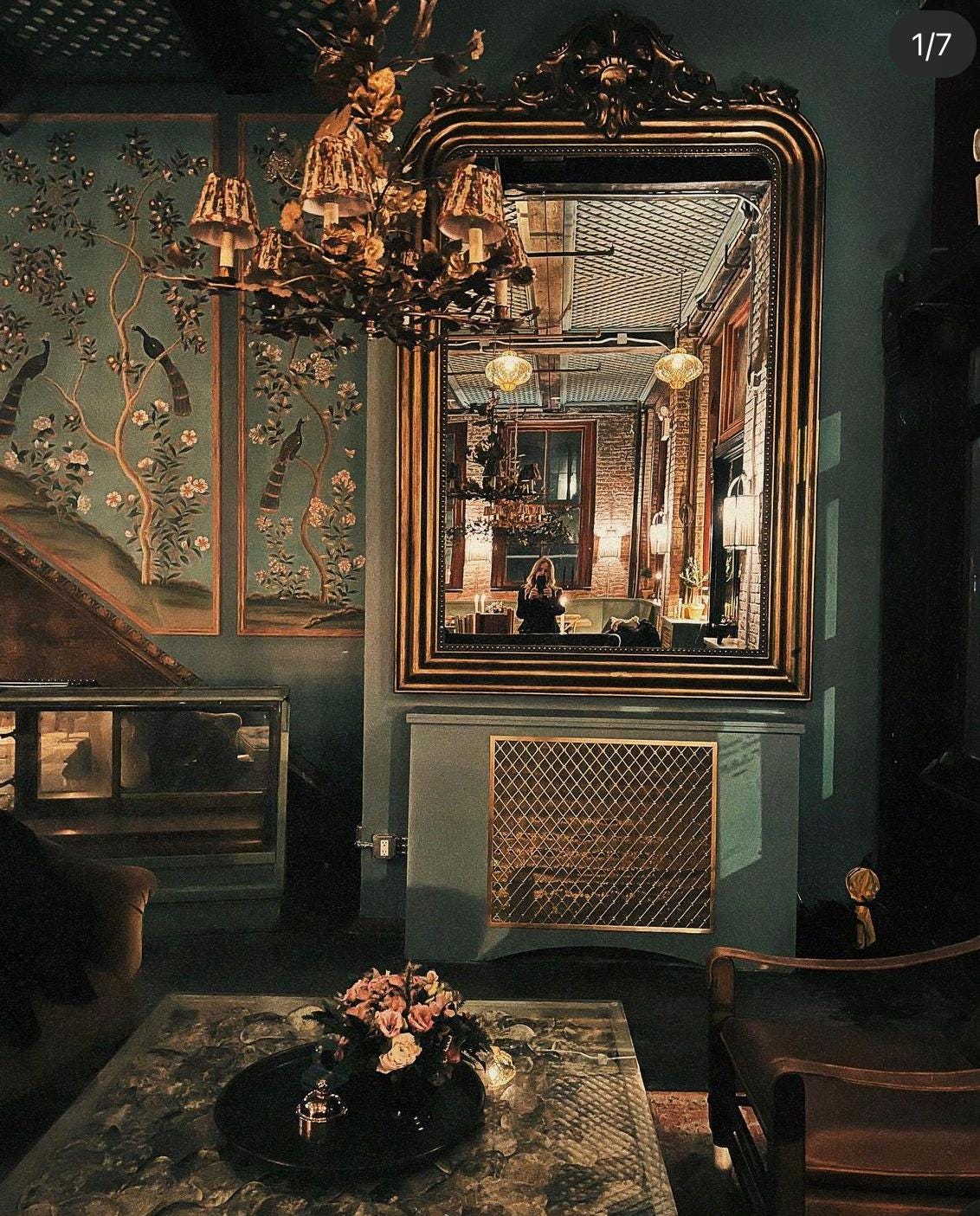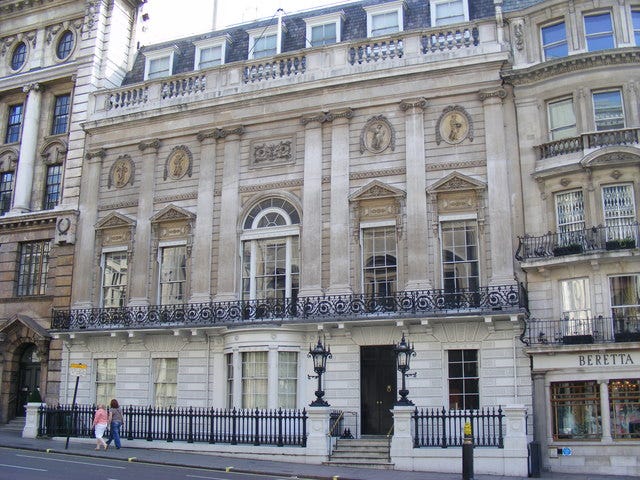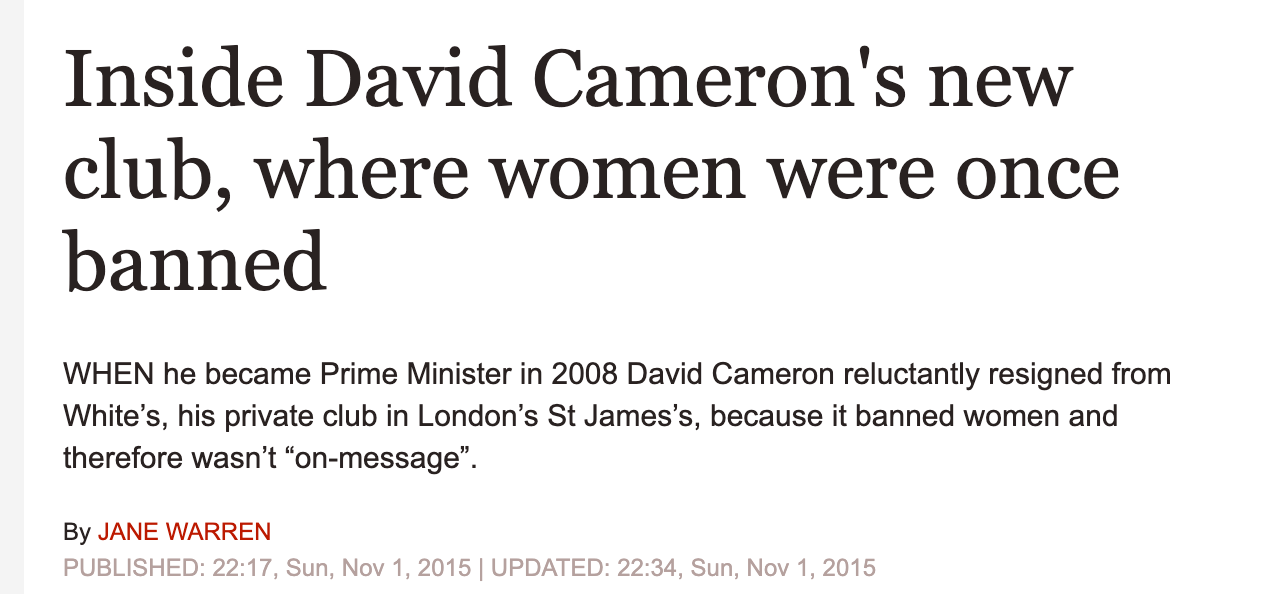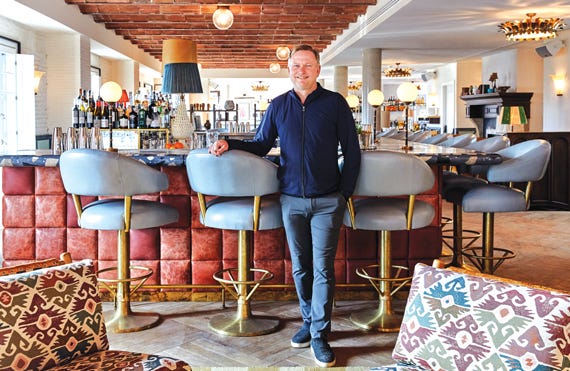The Rise of Soho House Part I: Highly Public Exclusivity and The New Aristocrats
How Soho House rode the rails of new celebrity & status voyeurism all the way to an IPO
Cafe Society is Maxwell Social’s semi-weekly magazine on the intersection of community and society — an anthropological look at the underpinnings of what makes the world tick, written by David Litwak (@dlitwak) and the Maxwell team. Maxwell is building a new type of social club, if you’d like to apply go to www.maxwellsocial.com and if you’d like to book an event get in touch here.
Soho House is the most talked about, least private, private club in the world. It has the most members, over 110,000 at last count, across the most geographies - 27 locations in 12 countries. It was featured in Sex and the City. It has managed to grow and scale and maintain some aura of exclusivity as it expands to ever more locations, and is the format that many newer clubs and elite co-working spaces from The Wing to Neuehouse, Spring Place and The Assemblage have attempted to remix to capture some of its magic.
And it’s probably the company I not-so-subtley shit on the most.
But even I will concede that while I disagree with their fundamental business model if you are trying to build community, Soho House is undoubtably clever -- they nailed the zeitgeist around exclusivity and community as increasingly important parts of our society earlier than anyone else, and recognized two key trends:
The Private Club Model Needed to be Upgraded for the New Aristocrats: Celebrity Culture
Exclusivity/Elitism could be Uncoupled and Sold Separate from Intimacy
Soho House has nailed popular culture, the hype around “community” and been able to monetize and exploit it better than anyone else in scalable business form.
So in honor of their pending public listing I decided to do a deep analysis of what led to the rise of Soho House and what it says about our society.
Part I will go into the beginnings of Soho House in London, focusing on the London private club scene it launched into in 1995 as a media & arts focused alternative to the traditional clubs focused on the aristocratic hierarchy.
Part II will go into the modern Soho House and the uncoupling of exclusivity & elitism from intimacy, the bundling in of various amenities, and how that permeates every part of their business and brand.
Part 1: Private Clubs, Celebrity Culture & The New Aristocrats
To fully understand Soho House’s rise we need to understand the history of the private club scene in London and in NYC. Around the time Soho House started, London’s private clubs were dominated by stodgy, traditional institutions, with Soho House and a few challengers as the outliers.
Launched in 1995, the NYTimes later wrote, “In London, Soho House is part of a generation of clubs that have opened since the 1980's, like the Groucho Club and Home House, which have become popular with fast young film and media crowds. Unlike the old-line men's clubs, which discourage talking business, the newer ones promote networking, book parties and cliquishness. Women are encouraged to join. They have a reputation for smoky, drinky evenings that sometimes make the tabloids.”
The most shocking revelation to me was that some of the oldest and most traditional clubs in London are still restricted to men. As Guest of a Guest elaborates:
“The most obnoxiously testosterone-filled is White's, the oldest and most exclusive club in London. It is part of a trilogy of clubs with Brooks's and Boodle's that rule the upper class and openly have no plans of ever admitting women.”
These institutions have been around for literally hundreds of years — White’s (above) was founded in 1693. But having a penis isn’t enough, you need to have the right pedigreed penis as well. Guest of a Guest continues:
“Look around the English government and powerful CEOs. It doesn't only matter how much money you are making in order to be a member. You need the proper upbringing and education which for the UK means Eton College followed by either Cambridge or Oxford. After that, it can take up to 10 years to get your application accepted. We wouldn't hold our breaths.”
Rumor has it when the recent Prince was born his application was submitted to White’s immediately. David Cameron, the former UK Prime Minister, famously gave up his membership in 2008 after years of being a part of it, in what I imagine must have been a “Shocked! Shocked that there is drinking in this establishment!” type of moment.
While less retrograde, the U.S. was no exception to the fairly stodgy culture of private clubs, and while American cities didn’t have as many private clubs as London, they did exist and thrive at one point. In 1902 there were 38,000 memberships in 157 clubs in New York City alone. While many of them faded by the turn of the millennium, old clubs like the University Club, the Harmonie, the Union Club and more were still around and some of the only real options for people looking for that sense of intimate & elitist camaraderie. But again, the bar was high - in many cases a prospect had to ask 10 or 15 members to write letters of support.
It was into this scene that Nick Jones launched Soho House.
Nick Jones & Over The Top
In the 80s, Nick Jones was a, by his own admission, fairly mediocre restauranteur in London with a concept called “Over the Top,” a fast-casual meat + sauce idea that failed, resulting in Jones closing down most locations except for one that was turned into a french brasserie, Cafe Boheme on Old Compton Street in Soho. When his landlord offered him the office above his last remaining spot in 1995, he launched a private club in the space focused on the creative class.
Soho House wisely attached itself to a different type of cool kid - instead of the aristocracy, which White’s and other less exclusionary (when it came to gender at least) clubs like Annabel’s had a monopoly on, they focused on a newer source of glamour - media, TV, the movie industry, and creatives in general were the new cool kids that they hitched their horse to.
The dress code and style reflected that industry’s mores. I grew up in California, dominated by the twin creative industries of entertainment and tech, where suits were worn by the service providers, the lawyers, bankers & accountants, NOT the creative people who actually ran the industry and could call the shots. I remember when I went to a shooting of That 70’s Show in LA when I was young, my mother leaned over to me and joked that “you can always tell who the assistant is by who is wearing the suit.”
Nick Jones seems to have understood this reverse dress code of the new creative world — Soho House had a no “suits” policy in the figurative sense, prohibiting finance types from membership in the first place, but in the literal sense as well:
“Jones freely admits he wants to see less suits lounging about — and he kicked up a media storm last summer when Soho House requested members not wear suits and ties.”
It may seem obvious in retrospect, but Nick Jones and Soho House deserve recognition that the prestige associated with a “private club” didn’t have to be linked to just the traditional aristocratic hierarchy, it would actually fit into just about any hierarchy. And the media industry was the perfect opportunity - it’s no coincidence that both of the two well known clubs to start in this time period focused on the media industry, with the other the Groucho Club:
“The two clubs' members are two tribes, divided largely (though not exclusively) by age and media speciality. The Groucho set tends to be drawn from journalism, publishing and television; and consists of established, if not establishment figures . . . Soho House is younger in spirit and appeals to the newer advertising, film and internet set.”
If you need more proof - the royal couple known to be affiliated with Soho House is the one that left the royal family and includes movie star Meghan Markle. The new entrants were savvy enough to choose to ride the rails of Hollywood glamour over old school traditional prestige, where there was too much entrenched competition.
Expansion & A U.S. Experiment
Soho House expanded rapidly by private club standards, launching multiple houses and finally coming over to NYC in 2003. To give you an idea of what an outlier that is - Annabel’s has reportedly contemplated locations in 3-4 other cities for years and hasn’t pulled the trigger, and Robin Birley’s 5 Hertford St, considered to be one of the go to spots for the aristocratic elites has been rumored to be opening a spot in New York for over a decade, with multiple false starts.
Success wasn’t guaranteed — it wasn’t accepted, again, that the private club model often associated with aristocratic English landed gentry would translate outside of England. The NYTimes asked at the time if it was “possible for Mr. Jones to create a club for a chic, select set from scratch without seeming like an uncool and pouty 8-year-old boy who nails a ''Members Only'' sign to his treehouse?”
Jones launched his New York location for an estimated $15 million, funded by the likes of David Bowie, and launched with charter members like Graydon Carter and more to obvious success, but not without some snafus - “‘Nick struggled to get across the idea to Americans that Soho House wasn’t like a country club and you couldn’t just pay your way in,’ says a colleague from the time.”
By 2008, Soho House was short on cash, leading to a major injection by Richard Caring, the London restauranteur, who bought a majority stake in the chain. In 2012 Ron Burkle came in as the majority shareholder, and has been the financial force behind Soho House’s expansion since then.
There were famous stories that popped up during their expansion. The murder of a fashion designer by her trust fund boyfriend. The actual purging of “suits” - when Soho House kicked out 500+ of their less “creative” members. The rejection of Kim Kardashian for membership.
But it was around the time of the NYC Meatpacking club launch in 2003 though that the first inklings of what would allow Soho House to scale their sense of exclusivity started to become more clear.
Highly Public Exclusivity
Soho House was one of the first private clubs to embrace media & Hollywood, but it was also the first to embrace the sort of public “private” moments of our celebrity culture, the tendency to broadcast our most intimate moments that is a hallmark of the social media era.
While “it's rare to find photos or descriptions of the inside of White's,” Soho House wasn’t so coy - shortly after the New York Club’s launch it was the subject of a Sex and the City episode.
On the launch of the NYC chapter, the NYTimes editorial profiled a member named Bob, who elaborates,
“The charm isn't the privacy. It's the highly public exclusivity, not unlike being at any hot party with Alexander McQueen, Julianne Moore, Candace Bushnell, Adrien Brody and lots of thin English people. As unseemly as it may sound, Soho House is a place to go where others know they can't, even (and heaven forgive me) some of my friends. ''Will you sponsor me to get in?'' several asked when I took them.”
Yes, Soho House has a no photo rule, no posting on Instagram, and a do not approach rule, but it sold “privacy” in the exact format the new, attention seeking media centric clientele wanted it - a sort of highly public exclusivity that I can’t help but compare to social media - don’t talk to me, but just watch me and be jealous. Telling someone to meet you at Soho House for lunch is a not-so-subtle humble brag — you may want to get lunch but what you really want is for them to know you are a member, a sort of status voyeurism.
It’s no coincidence that Facebook was started in 2004 and Soho House started their aggressive expansion in 2003 with their New York club - while both Groucho Club and Soho House had the media target demographic right, Soho house timed their expansion perfectly and cultivated a demographic that was increasingly existing in public.
While social media was allowing us to be accessible, but at a distance, to develop our aspirational brand and “connect with our audience,” Soho House was providing a stage for those very same people to peer in on each other’s lives but without any of the complications of ACTUAL connection.
It’s important to understand how different the idea of “highly public exclusivity” was from the traditional private club model — the traditional British private club was was more about highly private debauchery. The intimacy and privacy that a private club offered allowed allowed for real connection.
The combination of British exclusivity with American exhibitionism led to a private club that, despite the ban on Instagram posts, was tailor made for the evolving psychology of the Instagram age and it’s status voyeurism and started prioritizing intimacy less and less.
Kim Kardashian, The Real Housewives & The Illusion of Intimacy
But perhaps the best lens to view Soho House through is not social media but reality television.
Back in 2015, Soho House was framing their rejection of Kim Kardashian as a case of lacking artistic merit.
'We denied access to every Real Housewife who applied,' said Tim Geary, the LA branch's former director of membership. 'Kim Kardashian has unsuccessfully tried numerous times.'
Leaving aside for the moment how cruel it is to publicize someone’s rejection, even if it’s a reality star, Soho House just seems a bit too eager to tell everyone how much they don’t want anything to do with people who are well . . . professionals at engaging in highly public exclusivity.
Perhaps they rejected Kim Kardashian because she would hold too much of a mirror up to them — reality stars are the logical conclusion of this phenomenon, the focus on fake reality and faux intimacy that are essential to highly public exclusivity, and by rejecting the Kardashians, Soho House could pretend like they weren’t engaging in the same exact illusion of intimacy that they were.
Social media itself has evolved more and more into this direction, into a rolling reality TV show, with TikTok Hype Houses bearing a startling resemblance to every “let’s put a bunch of attractive people in a house and see what happens” reality TV show since The Real World.
But of course no one truly believes the Kardashians are hashing out their real family issues on television unscripted, or believes the Instagram posts of you in the Maldives are fully representative of your day to day. And when the woman with a foot fetish on OnlyFans to whom you pay $15 month wishes you happy birthday, most of us realize that this isn’t real intimacy.
We allow ourselves to be fooled, but in the end we are at least cognizant that we are indeed being fooled. In the end we know that the stripper doesn’t ACTUALLY like us.
But Soho House seems to be successfully fooling a lot of people into thinking that, well, they are actually part of a private club and not a gated restaurant.
Soho House has realized that just like Instagram influencers, OnlyFans and Reality Television stars, sometimes the illusion of intimacy is just as sellable and a hell of a lot more scalable than actual intimacy.
Next week we’ll dive deep into the Soho House value bundle and more into exactly how Soho House has managed to have their cake and eat it too — how have they managed to unbundle intimacy from the traditional private club bundle that was formerly so dependent on it, and what have they included instead?
And if you enjoyed our newsletter please send it to a couple friends and subscribe!
Have a great week!
David (@dlitwak), Kyle, Joelle, Dana









I love this series. It's hard to find info on Groucho Club or Home House in detail. Thanks for this :)